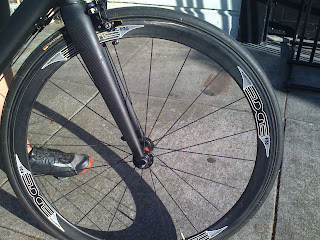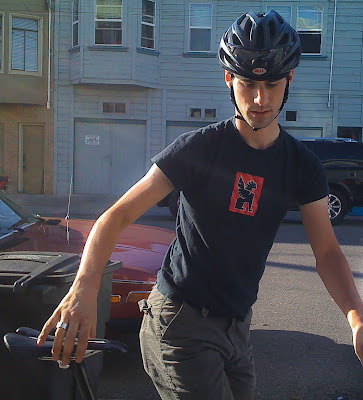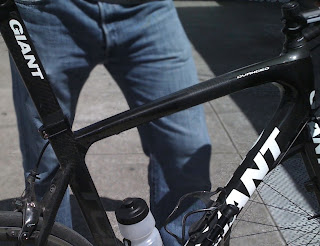Until a few years ago carbon-fiber rims were seen very rarely on our roads. Usually, they were
reserved for racing by pros and were equipped almost exclusively with tubular tyres. Well, we
know that this is no longer true. Because they are generally lighter than
alloy wheels, not only carbon-fiber rims are seen with increasing frequency on our roads,
dodging the typical traffic on the ever-present pot holes, but they also come fitted also with clinchers. They are popular, some would say, even fashionable among the
elite of the road warriors.
This Standard IIIc is a set
of wheels by a manufacturer we have previously mentioned, Lightweight, owned by
CarbonSports, a company based in Germany. Very dedicated crafts people make bicycle wheels pretty much by hand, without shortcuts or compromises on quality, in two facilities in Friedrichshafen,
on the German shore of Lake Constance, and Hailfingen, about 25 miles south of
Stuttgart.
They have been doing so
since the early 1990s, when the famed Heinz Obermayer and Rudolf Dierl founded
the company in a garage. As we all well know, garages are the ideal stepping
ground for new companies. They applied what they had learned in the aerospace industry to bicycle wheels.
Today Lightweight have
accumulated some of the best accolades in the category and, most flattering for
them, are under attack by an increasing number of competitors. Their status is
nearly mythical.
Innovation looses its flavor
very quickly, unless it is backed by uncompromising quality. That’s exactly
where Lightweight wheels dominate the competition. The tolerances are so tight
that some have even suggested that the wheels are made of one piece of
carbon—no joints. Well, it is true that that the spokes are actually made of
fibers, later reinforced with Kevlar, that are woven into the rims. This
technique allows for the wheels to be very stiff laterally, but smooth and
comfortable when used on the road. It also makes them very durable. Even the hubs are Lightweight, and only the internal free-hub mechanism and spline are made by DT Swiss.
Typically, using the brakes
with carbon-fiber rims require a steep learning curve. Not so with Lightweight
wheels. The brakes produce a very gradual effect on the rims, pleasantly similar
to that of alloy wheels.
As we would expect, these
clincher wheels are light. With tubes and clincher tyres, the set weighs 772
gr. For the front wheel and 892 gr. for the rear wheel. That an amazing 1,664
gr. for the set. Once again, that is their weight with tyres.
The wheels come with their
own quick-release skewers, made of a combination of titanium axles and carbon-fiber and aluminum levers. They weigh just 43 gr. That's light! They are also understated, like some other well-known German products, such
as sports cars, that don’t need much chrome or flashy details to highlight their lines or performance. They come all packaged in a black box with silver lettering, just
like a piece of jewelry—which they are, in some ways.
It takes about a week to
produce a Lightweight wheel, from the beginning to the end of manufacturing. There
aren’t many available in the world and are in great demand. For the moment,
this is the only set to be found in out fair city.




























